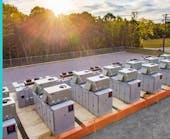Golar Gives Black & Veatch Go-Ahead on Construction of Liquefaction Tech for LNG Vessel
Shipping firm turned liquified natural gas infrastructure owner Golar LNG has issued a notice to proceed on construction work for its Golar MK II FLNG production vessel.
U.S. engineering and construction firm Black & Veatch, working as a sub-contractor to China-based CIMC Raffles, will provide its PRICO liquefaction technology as part of the FLNG (floating LNG) project. Black & Veatch also will contribute engineering design, procurement and commissioning support for elements of the topsides portion of the construction.
CIMC will build and install the topside modules for the project. The Golar MK II FLNG vessel will cost close to US$1.6 billion to construct and, once operational, should deliver liquefaction capacity of about 3.5 million metric tons of LNG per year, according to reports.
Liquefied natural gas is methane-heavy natural gas chilled to minus 260 degrees Fahrenheit, making it liquid, less pressurized and more stable for shipping. The U.S.’s historic shale gas production rise has elevated the country into the world’s top LNG exporter.
“The MK II will enable additional, flexible sources of affordable LNG to be processed to support the global need for energy security and resiliency,” said Black & Veatch’s Fuels & Natural Resources sector President, Laszlo von Lazar, in a statement.
Contractors expect to complete the vessel construction by the fourth quarter of 2027. Black & Veatch also supported the construction of Golar’s other FLNG vessels, the Hilli and Gimi.
Black & Veatch first developed its natural gas liquefaction technology in the 1960s. The company’s PRICO LNG facilities include projects on the Texas Gulf Coast, United Kingdom, South America, Africa and China.
The U.S. ranked first last year in LNG exporting globally, according to the federal Energy Information Administration. Daily LNG exports averaged 11.9 billion cubic feet per day, which was 12% higher than in 2022, according to the EIA.
Europe is the top destination for U.S. LNG experts, with more than two-thirds going to nations on that continent. Much of northern Europe is transitioning away from Russian natural gas after Russia invaded Ukraine two years ago.





